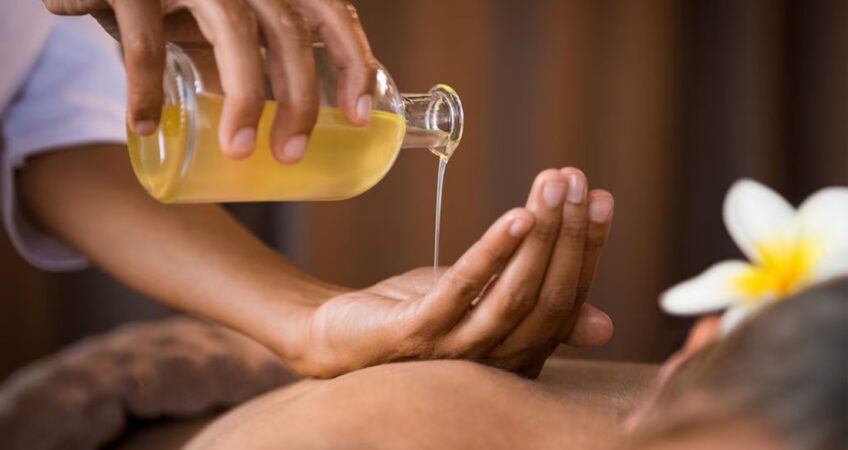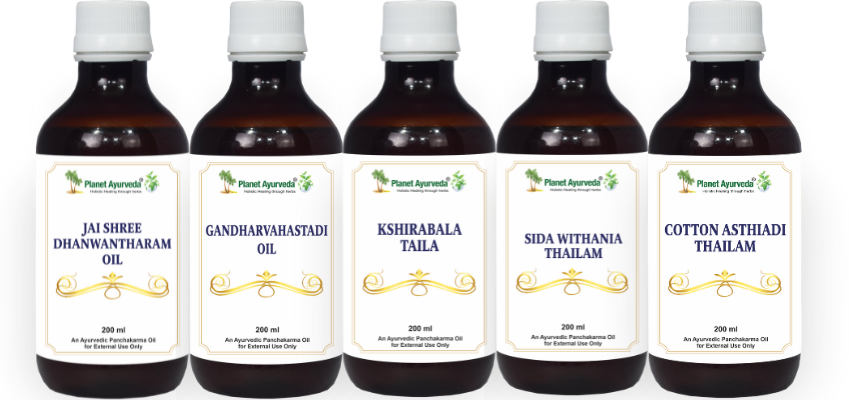The Healing Essence of Ayurvedic Oils
Introduction
In Ayurveda, Oil is regarded as a vital medium for delivering the therapeutic essence of herbs deep into the body. From daily Abhyanga (Oil massage) to specialized Panchakarma therapies, oils form the foundation of nourishment, rejuvenation, and detoxification. While regular base oils like sesame or coconut are highly beneficial for everyday use, Panchakarma oils are more potent and therapeutic. They are carefully infused with herbal decoctions, pastes, and other natural ingredients to achieve specific healing actions. Planet Ayurveda offers a wide range of authentic Ayurvedic Panchakarma oils, prepared using classical Ayurvedic methods to ensure purity, potency, and traditional integrity.

How Ayurvedic Oils Are Made?
Components of Ayurvedic Oils
- Paste of Herbs (Kalka)
- Base Oil (Sesame oil / Mustard oil / Coconut oil)
- Herbal Decoction (Kashaya)
- Milk (Go Dugdha)
Proportion of Components
- Paste of Herbs (Kalka) – 1 Part
- Base Oil (Sesame oil / Mustard oil / Coconut oil) – 4 Parts
- Herbal Decoction (Kashaya) – 16 Parts
- Milk (Go Dugdha) – 4 Parts
Steps of Oil Making
The preparation of Ayurvedic medicated oils (Taila Kalpana) is a detailed and methodical process that combines traditional wisdom with careful precision. The goal is to infuse the therapeutic properties of herbs into a base oil, creating a potent formulation that supports healing, rejuvenation, and balance of the doshas. Below are the classical steps followed in the making of Ayurvedic oils:
Preparations
- Select and Prepare the Base Oil: Choose a suitable base oil such as sesame, coconut, or castor oil according to the therapeutic requirement. Keep it ready for the process.
- Prepare the Herbal Decoction (Kashaya): Collect the herbs mentioned in the formulation and prepare a decoction by boiling them in water until it is reduced to the prescribed quantity. This step extracts the water-soluble active components of the herbs.
- Prepare the Herbal Paste (Kalka): Grind the required herbs into a fine paste using the decoction or other prescribed liquid. This paste helps to incorporate the fat-soluble properties of the herbs into the oil.
- Take fresh cow’s milk (Go Dugdha): Strain it through a clean cloth to remove impurities, and gently warm it before use. The warm milk is then added to the mixture of base oil, herbal decoction, and herbal paste – according to the requirement of particular oil. This ensures better blending and enhances the unctuous and nourishing properties of the final medicated oil.
Cooking the Oil
After the Herbal Decoction (Kashaya) and Herbal Paste (Kalka) are ready, all three ingredients — the base oil, herbal decoction, and herbal paste — are combined in a specific ratio, typically 1 part paste, 4 parts oil, and 16 parts decoction and Cow’s milk – as per requirements. The mixture is heated over a mild flame and continuously stirred to ensure even mixing and prevent the paste from sticking to the bottom. The heating continues until the moisture from the decoction completely evaporates, and only the medicated oil remains.
Duration and Heating Guidelines
The oil must be heated until all the water content evaporates from the mixture. The final product should be free from any moisture, as even a small amount of water can lead to spoilage. A simple way to estimate completion is to observe the liquid level in the vessel. Before cooking, mark the initial level of oil in the container after adding the herbal paste. The final oil level should approximately return to the same mark once all water has evaporated (sometimes slightly higher due to the swelling of the herbal paste).
Signs of Proper Preparation
- The natural fragrance of the herbs becomes distinctly noticeable.
- The herbal paste can be rolled into a wick-like shape without sticking.
- When a small portion of the paste is placed on fire, it burns silently without making a crackling sound — showing that all moisture has evaporated.
- The oil begins to produce mild froth during the final stage of heating.
- Initially, the mixture looks like a uniform, muddy blend; as it nears completion, the oil separates clearly from the paste.
These signs collectively indicate that the medicated oil has achieved the right consistency and potency.
Important Precautions
- Never heat the base oil alone and then add the decoction — this can cause sudden splashing or explosions if the oil is already boiling.
- Maintain a moderate flame throughout the process to prevent overheating.
- Continuous stirring is essential while preparing both the decoction and the oil to ensure uniform consistency.
- Use a wide-mouthed vessel to allow faster evaporation of water and better control during heating.
- Be especially attentive during the final stage of heating, as overcooking can damage the oil’s therapeutic qualities.
- Filter the oil immediately after completion while it is still warm to ensure clarity and purity.
Duration of Preparation
- The entire process may take two or more days, depending on the formulation and quantity.
- On the first day, the decoction (Kashayam) is prepared and mixed with the oil and herbal paste. Heat it until it just begins to boil, then stop the process and cover the vessel with a lid.
- On the next day, heating is resumed and continued until the oil is completely ready.
- This multi-day method allows for deeper infusion of herbal constituents and results in a more potent and stable Ayurvedic oil.
The Role of Base Oils: Nature’s Carriers of Nourishment
In Ayurveda, Sneha Dravya or base oils form the foundation of every medicated oil, acting as natural carriers that deliver the therapeutic essence of herbs deep into the body tissues (Dhatus). Rich in essential fatty acids, vitamins, and antioxidants, they nourish, strengthen, and rejuvenate the body. Through the classical Sneha Paka process, base oils absorb both fat- and water-soluble herbal components, becoming potent therapeutic mediums. Their molecular structure allows deep skin penetration, carrying active compounds to the target tissues. Thus, Ayurvedic oils work beyond the surface, promoting detoxification, nourishment, and tissue regeneration for overall health and balance.
Commonly Used Base Oils, Their Actions and Uses
| Base Oil | Primary Action | Best For |
|---|---|---|
| Sesame Oil | Strengthening, warming, grounding | Vata disorders, Muscle and Joint weakness |
| Coconut Oil | Cooling, calming, soothing | Pitta imbalance, skin issues, hair care |
| Castor Oil | Detoxifying, anti-inflammatory | Arthritis, swelling, chronic pain |
| Mustard Oil | Stimulating, clearing, warming | Kapha imbalance, sluggish circulation |
What Makes Ayurvedic Oils Different From Base Oils?
Ayurvedic oils differ from simple base oils in both preparation and therapeutic potency. Base oils like sesame, coconut, or castor are pure natural oils that primarily nourish, lubricate, and protect the skin. In contrast, Ayurvedic oils are medicated formulations created by processing base oils with herbal decoctions (Kashaya) and herbal pastes (Kalka) through the traditional Sneha Paka method. This process infuses the oil with the active phytoconstituents of herbs, enhancing its healing strength. As a result, Ayurvedic oils act not only as moisturizers but as therapeutic agents that balance doshas, detoxify tissues, improve circulation, and support specific health conditions.
Why Traditional Preparation of Ayurvedic Oils Matters?
The traditional preparation of Ayurvedic oils is vital because it preserves the authenticity, potency, and holistic healing qualities described in classical Ayurvedic texts. The Sneha Paka process — involving precise ratios of base oil, herbal decoction (Kashaya), and paste (Kalka) — ensures complete extraction of both fat- and water-soluble active compounds from the herbs. Slow heating with continuous stirring helps maintain the natural integrity of ingredients and prevents nutrient loss. This careful method transforms simple base oil into a powerful therapeutic medium that deeply penetrates tissues, balances doshas, and supports healing, rejuvenation, and long-term well-being.
The Ayurvedic Way of Using Oils
Ayurvedic oils are used in a variety of therapies to promote healing, nourishment, and balance in the body. Common therapies include Abhyanga (Oil Massage), Snehana (Oleation Therapy), Basti (Medicated Enema), Nasya (Nasal Therapy), Shirodhara (Forehead Oil Pouring Therapy), Akshi Tarpana (Eye Nourishing Therapy), and Local Basti (Oil Pooling Therapy). Planet Ayurveda offers a range of authentic Panchakarma oils specifically formulated for these therapies. For example, Jai Shree Dhanwantharam Oil and Gandharvahastadi Oil are ideal for Abhyanga and Snehana to strengthen muscles and joints, while Kshirabala Taila is used in Shirodhara and Akshi Tarpana to nourish nerves and eyes. Oils like Sida Withania Thailam and Cotton Asthiadi Thailam support Basti therapy for bone and joint health. Using these oils in the right therapy ensures deep tissue nourishment, detoxification, and overall rejuvenation, enhancing the effectiveness of Panchakarma treatments and daily Ayurvedic self-care.
Link to buy Herbal Oils, please visit store.planetayurveda.com/collections/herbal-oils
Conclusion
Ayurvedic oils are more than just oils with herbs; they are carefully made natural medicines that carry the healing power of plants deep into the body. The traditional method, followed at Planet Ayurveda, ensures that every oil is pure, strong, and effective. Unlike regular oils, these medicated oils can reach deep tissues, nourish the body, remove toxins, and balance the doshas. Regular use helps relax the mind, strengthen the body, and restore overall health. By combining natural ingredients with time-tested Ayurvedic methods, these oils provide gentle, complete, and long-lasting healing for body and mind.




